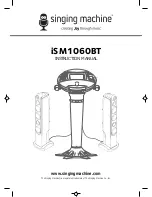
14
© 2006 Wohler Technologies Inc. ALL rights reserved
AMP1A-4S/-10S/-LP4S/-LP10S
User Manual P/N
821527
Rev-
B
Section 3: Technical Information
General Mechanical Observations
Elimination of cabinet and component sympathetic vibrations (resonances) requires considerable attention to mechanical details.
Because of this, and the physical constraints of the speaker’s acoustic enclosures, even minor changes to any of the mechanical
details of the unit can seriously impair its acoustic performance. This especially applies to the speaker baffles. If mechanical
work on the unit is necessary, be sure to make adequate notes to permit accurate reassembly.
Unfortunately, the unusual and wholly proprietary method of magnetic shielding is usually degraded slightly by any disassembly of
the unit, except removal of the rear panel. Almost any maintenance or repair will require removal of the cover. If an immediately
adjacent video monitor shows magnetic interference after reassembly of the unit, it must be returned to the factory to restore the
shielding completely.
General Audio Circuitry Observations
Since a single-sided power supply is used, all amplifier sections are “biased” with a 1/2 supply reference, so all opamp signal
terminals on the main board should have a DC level of +12V, +/-0.7V. Signal inputs to the main audio board from any of the input
select circuits are via the balanced input stage, in lieu of the XLR analog inputs on the basic unit. Signal feed points for level
meters and the phase indicator are immediately after the input stage, and before the volume control section.
The signal pick-off for the headphones is after the volume and balance controls. Speaker muting is controlled by circuitry that
senses connection of headphones to the jack.
The power amps are attached to an aluminum heatsink plate (which is also connected to the circuit common for these devices).
The heatsink plate forms an operational module separate from the chassis, which allows access to the solder side of the circuit
board while power is applied to the circuitry. To avoid thermal shutdown of the power amp(s), they should NOT be operated
without their tabs being fastened to the heatsink plate.
Variations in the frequency response of different production runs of drivers has sometimes required minor adjustments in the
equalization/crossover components in individual runs of units. Some of these components may have values slightly different than
those indicated in the schematic, which are the nominal ones. If any of the drivers (speakers) are replaced, it may be helpful to
change some of these components to achieve maximum flatness of response.
The operating threshold of the woofer limiter is critical to both satisfactory reproduction of musical transients and preventing
damage to, or destruction of, the speaker itself. The side speaker output limiter circuits are similarly important, though not as
critically adjusted.
The woofer power amps are arranged in a bridge configuration; care must be taken to avoid letting EITHER speaker terminal
contact the chassis (common) OR THE GROUNDED LEAD OF ANY TEST EQUIPMENT so as not to short out the power amps.
The side speaker outputs are single-ended, so these precautions are not necessary for them.
General Technical Observations






































